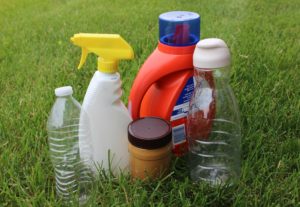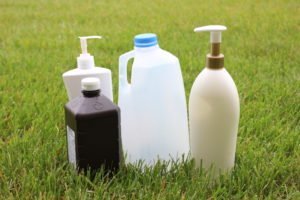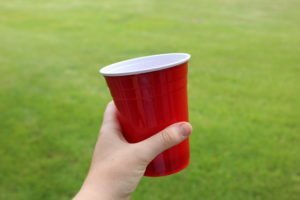
12 Jul What do the recycling numbers mean?
Most plastics have a number inside a recycling symbol on its bottom, but why is this number important or even there? These numbers are useful to consumers, they inform folks on what type of plastic the object is made of and if it’s recyclable. In addition, these numbers allow workers to sort the plastics, as certain types of plastic must be processed differently.
Number 1
polyethylene (PETE/PET)
Polyethylene is the most common type of plastic. It is lightweight, strong and often transparent. Soda bottles, water bottles, cooking oil bottles, and medicine containers are examples of number one plastics.
Number 2
high-density polyethylene (HDPE)
Number two plastics are a stronger version of PETE. It is resistant to moisture, hence its use for liquid containers like milk jugs and shampoo and conditioner bottles. HDPE can withstand years of weathering from rain and changing temperatures making it also a useful material for pipes and plastic lumber.
Number 3
Polyvinyl chloride (V)
Number three plastics are durable materials that are resistant to weathering and chemicals. Polyvinyl chloride also does not conduct electricity, which is why it is commonly used in wire, cables, pipes, clear medical tubing, and vinyl dashboards.
In addition, number three plastics are easily cleaned and can have single-use applications. In healthcare settings, this is beneficial because it can reduce infections.
Number 4
Low-density polyethylene (LDPE)
Number four plastics are a softer and more flexible version of HDPE. LDPE is used for wrapping films, grocery bags, and sandwich bags.
Number 5
Polypropylene (PP)
Number five plastics are more heat resistant and chemically durable than other plastics. Polypropylene is ideal for food packaging and storage because of these qualities. Tupperware, yogurt tubs, (orange) medicine containers, and plastic caps of soda bottles are examples of number five plastics.
Number 6
Polystyrene (PS)
Number six plastics are the most diverse plastic material. Chemical processes can return Polystyrene to its original state. This is an impressive feat as it’s one of the only plastics to be able to do so. Examples of this kind of plastic include plastic cups, disposable cutlery, packing peanuts, and styrofoam insulation.
Number 7
other
The least commonly used plastic is number seven. They can be a combination of any of the 1-6 plastics. In addition, this category can also include biodegradable plastics.
Recycling in Mankato
Mankato offers a detailed list of the different types of materials that are recyclable.
Sources
https://sites.google.com/site/rlmrecycling/home/what-do-the-recycling-numbers-mean
https://www.greenmatters.com/renewables/2018/09/13/ZG59GA/plastic-recycling-numbers-resin-codes









